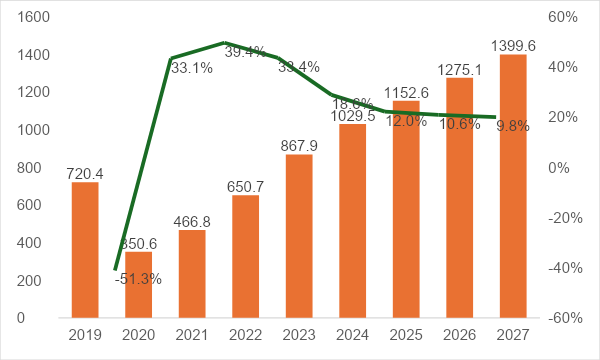
By 2023, the global wellness tourism market had fully recovered from its pandemic-era dip. By 2027, the market is projected to reach $1.4 trillion
Marie Driscoll, CFA, serves as an adjunct professor at The New School, FIT and CUNY, and is one of RETHINK Retail’s Top Retail Experts 2021-2024
The refrain of most consumer analysts and consumer brand and retail executives as they navigate a post-pandemic environment: “COVID changed everything.”
Lockdown and constrained social interaction meant business and personal travel was curtailed for a few years, while wellness – both corporate and personal – became a top-of-mind focus, adding a ripple to travel industry drivers and sparking an already growing pre-COVID trend of wellness tourism.
COVID-19 accelerated consumer awareness and deepened focus on all things wellness, highlighting the interconnectedness of our physical, mental, social and spiritual health. Entrepreneurs and established hospitality brands are creating wellness solutions that address more than one aspect of wellness, creating community and enjoying higher average tickets as a result.
Consumers are looking for holistic wellness solutions, as simple as a yoga mat in hotel rooms with dedicated wellness cable channels to nutritional food and beverage offerings. Technology can enhance in-room wellness with sleep and meditation apps. The solutions are as varied as the clients and the locals they travel to.
In California, hiking along the Pacific and sunset meditations are options, while in upstate New York, fly-fishing could be part of a meditative outdoor wellness retreat. Spas will see more IV therapies and non-surgical aesthetic procedures as beauty and wellness are increasingly integrated. ‘
The secular trend of the last twenty years has been a consumer shift to experiential spending over product spending with a short COVID-related reversal. In their search for the next exciting, meaningful, fulfilling experience, wellness tourism is part of the next frontier.
Wellness Tourism Tops Pre-Pandemic Levels
The Global Wellness Institute (“GWI”) defines wellness tourism as “travel associated with the pursuit of maintaining or enhancing one’s personal wellbeing,’ while the Wellness Tourism Association says wellness travel is “travel that allows the traveler to maintain, enhance or kick-start a healthy lifestyle, and support or increase one’s sense of wellbeing.”
An obvious caveat is that the concept of wellbeing is individual, personal, changes through life experiences and is contextual to culture. While wellbeing is a static state, wellness is a multidimensional lifestyle spanning many aspects of self-care – physical, mental, spiritual, financial, social, environmental, dietary, sexual and more. Wellness is also an active pursuit and engagement.
Suffice it to say, wellness tourism offerings are varied as providers attempt to address one or more of the aforementioned facets.

According to data from Statista, the global wellness tourism industry hit $720 billion in 2019 before contracting 51% in 2020 due to COVID.
By 2023, the global wellness tourism market had fully recovered and stood at $868 billion, up 33% year over year and up 21% from 2019 levels. By 2027, wellness tourism is projected to be a $1.4 trillion global industry, achieving a 12.7% 4-year compound annual growth rate.

These are big figures and sit under the umbrella of the Global Wellness Institute’s estimate for the global wellness economy of $6.2 trillion in 2023
Destinations emphasizing fitness and nature-based activities, such as guided hikes, ocean fronts, and coastal settings that blend wellness activities into the location are becoming the status holiday and selfie-moment of many wellness travelers.

Wellness Travelers Spend More Than Traditional Vacationers
Travel/vacations are planned for months in advance, often making the destination and event packed full of anticipation of the extraordinary – meeting new people, learning about new cultures and immersive experiences (cooking lessons, painting, or yoga) spanning new foods, cultural events and, of course, shopping.
Consumers save and plan for their holidays and there is a freedom with holiday spending that doesn’t occur year-round as consumers rationalize, they are on holiday, won’t return, “deserve it,” etc. And, consumers on wellness holidays spend more than those on traditional holidays. According to GWI, in 2022, the average international wellness tourist spent 41% more than the average tourist at $1,764 per trip.
Similarly, domestic wellness tourists spent 175% more than the typical domestic tourist (or $668 per trip). In its 2023 Global Wellness Tourism Economy report, GWI stated that in 2022, wellness trips accounted for 7.8% of all tourism trips but represented 18.7% of all tourism expenditures.
In 2022, the U.S. represented 24 % of wellness tourism trips and 39% of all expenditures driven by domestic wellness tourism, which accounted for 96% of wellness trips in 2022. GWI distinguishes between primary and secondary wellness travel – the former when wellness is the motivation of the trip and the latter when wellness is an add-on; secondary wellness trips represented 85% of wellness trips (88% of expenditures) in 2022.
Wellness for the Rich: Replenish, Recharge & Rehydrate
While there are explicit wellness destinations – hotel and resort spas account for 44% or more of wellness destinations in 2022 and were the only segment of spa establishments that increased in number since 2019 (up 25%), the growing consumer interest has traditional hoteliers and hospitality venues developing wellness offerings—often distinct, differentiated offerings for specific locations and in tandem with evolving consumer preferences.
For example, the Four Seasons Hotels (120+ locations in 47 countries) has significantly enhanced its role in the wellness tourism sector with new locations including wellness offerings, both mind and body that can be personalized with one-on-one consultations, fitness workshops and classes led by accredited experts, healthy meals as well as more traditional beauty and spa therapies.
The three-day retreat offering at Westlake Village includes two 60-minute Tranquility Massages, a facial, combo manicure & pedicure, all meals and snacks from the Wellness Kitchen, a body composition analysis, guided hikes, guided sunrise meditations, Wellness Kitchen cooking classes and group fitness classes, among other things.
The Spa at the Four Seasons New York Downtown has a variety of IV therapy drip formulations spanning potions to improve immunity, recover from a hangover, aid in weight loss or optimize longevity, gut health, stress, jet lag and detox. For a hefty $12,000, stem cell therapy and for $16,000, a combo drip of stem cell, exosomes and longevity therapy, are offered.
Spiritual self-care or SoulCare a spiritual practice to slow down the body, quiet the mind and reconnect with the soul is available as well to assist in self-discovery via somatic experiencing, yoga Nidra, visualization, meditation, breathwork and various grounding and nervous system regulation practices.
The Fairmont Century Plaza in Los Angeles goes the extra mile to offer Biohacking treatment on an anti-gravity bed and other procedures taken from sports medicine to restore health and improve well-being. The spa menu also includes a Himalayan salt room, aromatherapy steam room and body scrubs, along with personal and group fitness training.
Marina Kaydanova, ex-banker, entrepreneur and founder of BK Pilates, a New York City-based Pilates studio that has grown from one studio in 2012 to five in 2024 (two in Manhattan, two in Charlotte, North Carolina, and one in Mount Pleasant, South Carolina) as she has grown to meet demand for a well-rounded exercise system that complements any physical and mental activity and reflects the growing demand for holistic well-being and the transformative power of mind-body practices.
Kaydanova is currently stretching from Pilates to venture into the world of health, wellness, and hypnotherapy while also launching wellness retreats in fun destinations (she is scouting out her first wellness retreat and considering Bail for 2025).
“I envision these wellness retreats as an extension of our commitment to holistic wellness and personal growth,” Kaydanova said. “By offering a blend of Pilates classes, hypnotherapy sessions, mindfulness practices, and other wellness activities, these retreats will provide a comprehensive and rejuvenating experience for participants, providing a space to disconnect from their daily routines, reconnect with themselves, and embark on a journey towards improved health and well-being.”

